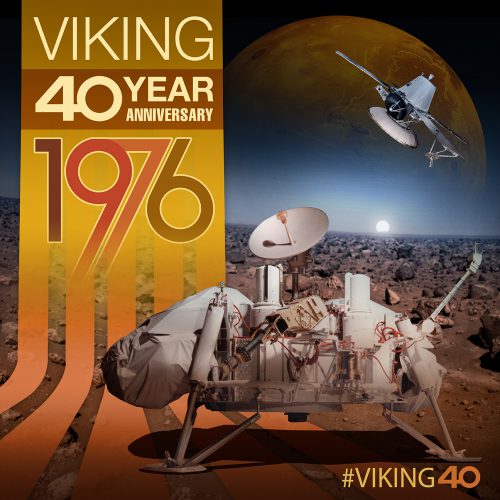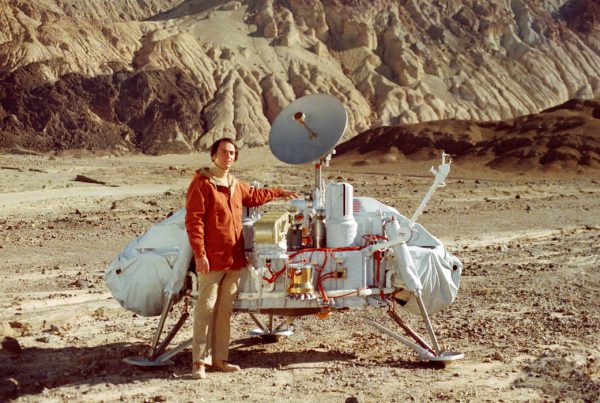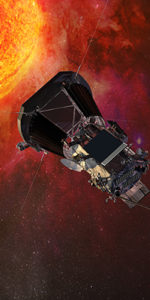
July 20, 1976, will be forever remembered by space enthusiasts. On that day, Viking 1 became the first U.S. spacecraft to land on another planet—in this case, Mars (the USSR Venera 9 spacecraft landed on Venus in 1975). That lander, and Viking 2 which followed it Sept. 3, 1976, paved the way for more complex missions later on, which would begin to finally unlock some of the secrets of the mysterious Red Planet. The two Viking landers, and their counterpart orbiters, were genuine trailblazers, opening up the vast Martian landscape to robotic and human eyes for the first time.
Viking 1 landed in the Chryse Planitia region, while Viking 2 landed much farther away in Utopia Planitia. The two landers were a joint project of NASA, the Jet Propulsion Laboratory, the Langley Research Center, and Lockheed Martin (Martin Marietta at the time before the merger with Lockheed Corporation in 1995). Their mission was a relatively simple-sounding one: to search for evidence of life on Mars. It was a bold move, and no one knew if it would pay off. Nothing like it had been attempted before, and trying to answer such a huge question the first time landing somewhere was no small feat, especially since there were still so many unknowns about the planet. Scientists had a general understanding of the surface conditions, but there were still many questions to be answered, and surprises to be discovered.
The first accomplishment of course had to be to land safely. As with all such landings, the several minutes during the landing sequence are a nail-biting time for engineers and scientists alike. Something could easily go wrong, but fortunately for the Viking team, it didn’t.

“The first white-knuckle event was the landing,” said Ben Clark. “Everything was happening as it was supposed to so we knew we had landed safely. We celebrated big time.” Clark headed the team that developed the x-ray fluorescence spectrometer instrument, which was used to determine the chemical composition of the Martian soil.
After the landing, the mission team and public alike breathlessly awaited the first photos from the surface. Unlike photos from missions today, the first image came in pixel by pixel, gradually revealing a rocky surface including one of the footpads. This was the first-ever close-up view of the Martian surface. At first glance, it was just a black-and-white photo of rocks, pebbles, and sand, nothing too weird or surprising. But it was historic.
“To see those photos was quite an event,” said Clark. “It was on national television, and there were only three channels at that time, so everyone saw it.”
Martin Marietta (later becoming Lockheed Martin) played a large role in the Viking mission. It built the robotic arms used to collect surface samples, various testing instruments, flight software and the aeroshell, an aerodynamic heat shield, and back shell, which protected the lander, as they descended to the surface. The company also built the Titan IIII rockets that launched the twin Viking spacecraft. Building the spacecraft took six years. Lockheed Martin has since adapted much of the technology involved for today’s missions, in particular the Mars Phoenix Lander and InSight lander, as well as all three current orbiters. It will also be involved in the upcoming Mars 2020 Rover.
“For Lockheed Martin, this mission was huge,” said Clark. “The most successful thing is that because we built it, all of the sudden, we were the wonder horse of the whole aerospace community. It was a well-known program that did almost the impossible and worked so well.”
The Viking landers performed amazingly well during their active time on Mars. Viking 1 set an endurance record, lasting 2,245 sols (Mars days), which was not broken until 2010, by the Opportunity rover.
“People look back at the last time they did something successful,” Clark added. “It’s sort of like families. You raise your children similar to how you were raised. Things get pushed forward generation after generation, and we have done that with the success of Viking.”
Viking also implemented a rigid sterilization program, where each lander was thoroughly sterilized before launch, to protect the Martian environment from contamination by any Earthly microbes which may have wanted to go for the ride.
In 1972, Dr. Nicholas Costes, a senior research scientist at NASA’s Marshall Space Flight Center, started to develop a concept for a future Viking lander 3 to have “elastic track bands” to enable it to rove around, something like tanks or bulldozers, but it was never funded.


As for Viking’s prime mission, how do you search for life on a planet when there are so many things that are unknown about the current and past conditions, and potential for habitability overall? NASA decided to take a direct approach and look for evidence of microbial life as we understood it on Earth. Three different biology experiments were included on both landers, but they were of course based on what was understood about Mars at the time. They were also very limited compared to what could be done today, but at the time were considered groundbreaking, and rightly so. The intense debate over the results continues to this day; while surprising chemical activity was indeed found in the soil, it was undetermined, and still is, as to whether microbes were involved or just exotic but lifeless chemistry. Dr. Gilbert V. Levin, an engineer and principal investigator of the Labeled Release experiment, has continued to maintain his position that both Viking landers did indeed find microbial life on Mars.
Samples were only able to be taken from shallow trenches in the sand; as is now known, ultraviolet solar radiation has sterilized the first few inches or so of the ground, which would effectively destroy any known microorganisms or organics on Earth. Also, we now know that the same soil contains high levels of perchlorates, salts which can also have the same effect. It seems to present a likely answer as to why Viking found no traces of organics, without which there could be no life, and which seemed to be in conflict with the biology experiment results. The results were discouraging, and prompted many scientists to abandon the hope for life on Mars. It would be over 20 years before another lander or rover was sent to Mars. Most experts agree now that to look for life on Mars, either current or past, future samples must be dug up from deeper below the surface. Until additional samples can be studied more closely in labs on Earth, the Viking biology experiments will continue to be a source of much debate.


At the time, planetary scientist and JPL director Bruce Murray was a lot more cautious about the prospect of finding life, then was Carl Sagan, of Cosmos fame, who the public most identified with. In his memoir, Murray noted that “the extraordinarily hostile environment revealed by the Mariner flybys made life there so unlikely that public expectations should not be raised.”
Post-Viking, NASA has taken a different route, studying instead the evidence for possible “habitable environments” in Mars’ past, rather than search for life itself. This has been the case until today, with a much more cautious, step-by-step approach, focusing on “follow the water.” It has now been well-established that Mars used to be much wetter than it is now, with lakes, rivers, groundwater, and possibly oceans. The idea that ancient Mars was at least habitable has now been firmly established. The next Mars rover mission, the Mars 2020 Rover, will be the first since Viking to address the life issue directly, although focusing on evidence for past life rather than present.

Viking may have been somewhat “ahead of its time” according to some, but it helped to establish the current methods for searching for alien life on our next door neighbor. Those methods could be refined and improved, to better search for something when we don’t even know exactly what it is we might find. Mars life might be similar to Earth’s at the microscopic level, or it could be completely different, we just don’t know yet.
NASA is also hosting live media events to celebrate the Viking mission, with a history discussion from 2:00 p.m. to 3:30 p.m. EDT on Tuesday, July 19, and a Viking 40th anniversary symposium from 8:00 a.m. to 5:10 p.m. EDT on Wednesday, July 20, at NASA’s Langley Research Center in Hampton, Va. Portions of those events, highlighting NASA’s Journey to Mars plans for future human missions, will air on NASA TV. The symposium will include 2o speakers including former Viking scientists and engineers. A detailed listing of events is available here.
Sending astronauts to Mars is still NASA’s overarching goal, even though there still isn’t a firm timeline.
“I’ve always thought the pursuit of human exploration of Mars was important,” said Clark. “The exploration will go faster. We can put geologists out there and we will have a better opportunity of finding life because they will be able to look under every nook and cranny.”
The Viking mission was an unprecedented success. As previously noted by Doug McCuiston, Mars Exploration Program Director
NASA Headquarters in Washington, “The Viking mission looms like a legendary giant, an incredible success against which all present and future missions will be measured.”
The Viking mission attempted to resolve one of the biggest questions of humanity: Are we alone? Unfortunately the answer is still unknown, but Viking paved the way for future missions and technology, undreamed of in the 1970s, which might be able to do just that.
More information about the Viking mission is available at the Viking Mars Missions Education and Preservation Project (VMMEPP) website and on the NSSDA website.
Want to keep up-to-date with all things space? Be sure to “Like” AmericaSpace on Facebook and follow us on Twitter: @AmericaSpace






The article is misleading. Lockheed and Martin Marietta were completely separate companies until they merged in 1995. Martin Marietta was involved in the Viking missions, Lockheed was not. While they are the same company now and I’m sure LockMart is happy to take credit, it isn’t accurate in that Lockheed Martin didn’t even exist in the 1970s. The article should have made that clear. Otherwise, great job 🙂
I’ve amended that, thanks. I was also going by Ben Clark’s quotes, which said Lockheed Martin instead of Martin Marietta.
For the sake of historical accuracy, the Soviet Venera 9 spacecraft landed on Venus in October 1975 transmitting the first pictures from another planet. But this article is a testament to the great work of the scientists and engineers of the Viking missions.
Whoops, meant to say first U.S. spacecraft, thanks. Fixed now.
I hate to say this–but there is a part of me that wonders if Viking didn’t set back Mars exploration.
Had one landed at Mt. Sharp–instead of in the middle of ugly rocks–we might have returned sooner.
They couldn’t have. The Viking landing ellipse was huge – 174 x 62 miles – and all that needed to be flattest terrain they could find to provide the best chances for a good landing. Prior to late 1969, the Viking landing site selection committee had very little good resolution imagery of Mars to work with (just 21 images from Mariner 4’s flyby). Before then the majority of Mars had only been mapped with telescopic and radar observations from Earth. In 1969, Mariners 6 and 7 flew by Mars, returning 201 images, and in 1971 Mariner 9 orbited Mars, returning 7,329 images and giving us a 1 km per pixel map of 85% of Mars for the first time, also discovering the Valles Marineris and the massive volcanoes in the Tharsis region. They were invaluable to providing the data needed for Viking landing site selection. Even so, the better cameras on board the Viking 1 orbiter found that the selected landing sites were too rough for landing – the Viking 1 lander was targeted for a smoother landing site chosen literally the week before it was commanded to separate from the orbiter to land on Mars. Viking 2 had been launched a few weeks later and also had its landing site switched to smoother terrain.
That said, the Viking missions did play a fairly large part in the lack of subsequent Mars missions. One part was their cost, $1 billion in 1970s dollars, the other, the negative results from the experiments used to attempt to detect life on Mars, which were often used to paint a negative picture of space exploration in general, and Mars exploration in particular. Their longevity may also have played a factor, Viking 2 lasted until April 1980, when its batteries failed, and Viking 1 survived until November of 1982.
It is true that the data preceding Viking Orbiters was not sufficient and required site ‘re’ certification using Viking Orbiter imaging. The gap in missions however was due to a variety of issues, not just one, and they included poor communication of the inconclusive results giving the impression of negative results rather than realigning with scientists proposals to conduct immediate followup missions to investigate additional locations and look for other chemical and biologic “organics”. Follow-up missions were to include rovers (of which there were 3 distinct proposals from JPL, LaRC, and Martin Marietta directly after Viking), Center differences on approach that could not be reconciled easily, as well as a redirection of funds to the Shuttle missions that began BEFORE Viking EOL. People forget that missions overlap for MANY years, and resources must be allocated well in advance of missions, which at that time would have meant before results were even in from Viking.
There are many other reasons for the lag period as well, but the research and momentum continued by those inspired by Viking AND Vikings, and Viking engineering, mission planning, and science results were used by ALL subsequent missions, so it is very inaccurate to say Viking cause the setback. Quite the opposite… Viking made the subsequent missions more cost effective, safe, and created the baseline body of knowledge needed to 1) get there 2) survive entry and descent 3) communicate successfully 4) Viking data is still being used…
Folks interested can learn more about Viking from VMMEPP. The dedicated Viking preservation institute, supported by Vikings and others committed to making accessible all Viking materials for public education and research.
The Viking Anniversary Reunion for all Vikings, was held July 16th, 2016 in Denver, CO with over 150 Vikings in attendance. Event led by The Viking Mars Missions Education & Preservation Project (VMMEPP) and sponsored by Lockheed Martin.
Vikings present for the all day Viking and Mars Exploration Education event were accessible to the public for questions during this daylong event.
Questions about Viking can be posed to VMMEPP who is supported by Viking Team Members and is the dedicated Viking resource for artifacts and archives. Responses will be made available as answers provided, vetted, and supported by documentation.